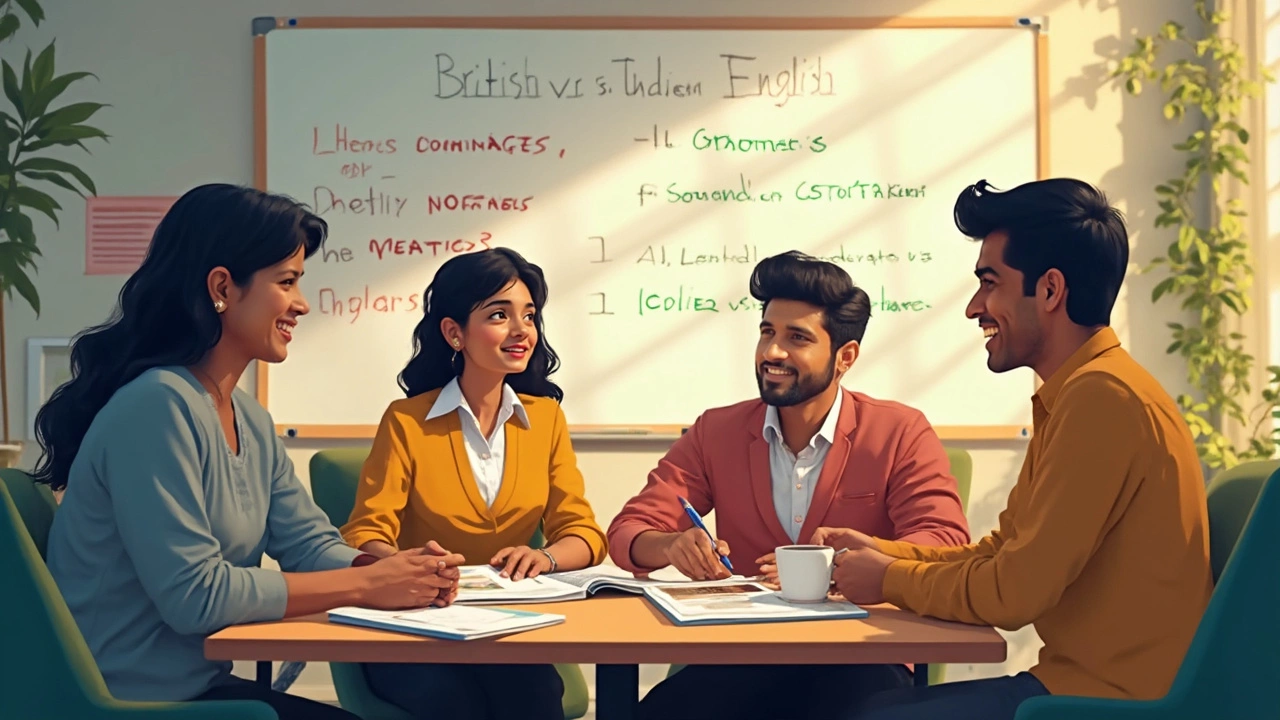English in India: Which Version Dominates English Courses?

English isn't just a subject in Indian classrooms—it's often the key to a good job or a spot at a top university. But here's the twist: not all English is the same. Walk into an English course or pick up a text book, and you’ll notice some words sound more 'London' than 'L.A.' That’s because British English is the root, thanks to history lessons India never asked for, but got anyway.
Still, the way Indians actually use English isn’t just a carbon copy of the Queen’s version. If you're trying to figure out which English shows up most in courses, or if you should learn 'colour' instead of 'color,' this is the stuff you need to know. Exams, workplaces, and even daily chat have their own blend—and if you’re aiming to crack an English test in India, or teach a class, knowing this is a massive time-saver.
- The Roots of English in India
- British English vs. Indian English: What’s the Real Difference?
- English in Classrooms and Exams
- Indian English in Everyday Life
- Tips for English Learners in India
The Roots of English in India
It all kicked off when the British ruled India for nearly 200 years, right from the mid-1700s till 1947. They brought their language with them, and by the early 19th century, English in India was set to become more than just the rulers’ language. Lord Macaulay’s Minute on Education in 1835 sealed the deal. The British decided English would be the go-to language for schools, colleges, and administration—basically, if you wanted a government job or to move up in life, you had to speak the Queen’s English.
But it wasn’t like everyone just dropped Hindi, Bengali, or Tamil overnight. The British didn’t bother building English schools everywhere, but they were very focused on creating a class of Indians who could help run things. Over time, English courses in India started popping up in universities and elite schools. Later, after independence, the language didn’t exactly pack its bags and leave. Instead, it found a comfortable spot as an official language along with Hindi.
If you look at the 2011 Census, India has over 125 million English speakers—making it one of the largest English-using populations outside the US and UK. And the number keeps growing, thanks to job markets, international exams, and the internet.
Quick breakdown of what shaped Indian English:
- British Empire introduced English for government, trade, and education.
- Elite schools and colleges (think St. Stephen’s in Delhi or Presidency in Kolkata) taught strictly British English to build future leaders.
- After 1947, English stayed as a main language—It’s one of two official languages for Parliament and most national exams.
- English language learning became a must-have skill, no matter where you lived.
So, if you’re in India and signing up for an English course, you’re really stepping into a piece of history. Not only are you learning a global language, but you’re also picking up local twists hundreds of years in the making.
British English vs. Indian English: What’s the Real Difference?
When you take a closer look at English in India, you’ll spot that the base is British English. That means most spelling, grammar, and usage in Indian textbooks and official materials follow British rules. So you get “colour,” “organisation,” and “centre,” not the American “color,” “organization,” or “center.” Even phrases like “Please revert back” and “Kindly do the needful” are super common in Indian workplaces but would sound weird to someone in London or New York.
Indian English, which you’ll hear everywhere from call centers to news channels, is like a remix. It keeps the British core but adds its own twist. For example, words like “prepone” (move something to an earlier date), “batchmate” (classmate), and “out of station” (out of town) wouldn't really make sense to a Brit. And sometimes, sentences are structured differently: “She is having two brothers” instead of “She has two brothers.”
- Pronunciation: Indian English is a lot closer to how words are spelled, while British English often drops or softens certain sounds.
- Vocabulary: Everyday Indian English uses words borrowed from Hindi, Tamil, and other languages—things like “crore” (ten million), “eve-teasing” (public harassment), or “co-brother” (brother-in-law).
- Spelling: Indian English goes with British spelling in most official places—schools, government exams, and media.
- Punctuation: Single quotes (‘ ’) are the default in India, while the UK usually goes with double (“ ”).
Here's a quick look at some common differences:
| Word/Phrase | British English | Indian English |
|---|---|---|
| Schedule | "SHED-yool" | "SKED-yool" or "SHED-yool" |
| Vacation | Holiday | Leave |
| Public holiday | Bank holiday | National holiday |
| To move a meeting earlier | Advance | Prepone |
| School friend | School friend | Batchmate |
And when it comes to most English courses or language exams in India, they almost always expect British English for all the spellings and formal writing. But step outside the classroom, and you’ll find that Indian English is a living thing, shaped by local languages and how people really talk. If you’re thinking about learning or teaching English here, it helps to know both sides of the coin.

English in Classrooms and Exams
Step into any decent classroom or check out what’s on an Indian board exam, and you’ll see British English everywhere. Most English courses and even top schools stick to UK spelling, grammar, and vocab. So, it’s “favourite” with a ‘u’ and not “favorite.” The textbooks and teachers are mostly on the same page, following the British model. This isn’t random—it goes all the way back to when the British had their boots on the ground in India, shaping how English is taught today.
The big exams—CBSE, ICSE, state boards, even college entrance tests—expect answers in British English. If you use American spellings or mix up formats, you can actually lose marks. Many schools and training centres make this rule pretty clear.
But here’s the interesting part. Spoken English, or what students use in daily chats and practice sessions, often slides into Indian English. You’ll hear phrases like “What is your good name?” or “passing out” (for graduating), things you won’t find in a UK or US classroom. But in writing, especially for exams and official reports, sticking to British rules keeps you safe.
Check this quick comparison to see what’s usually expected in Indian classrooms and exams:
| Aspect | British English (Taught/Preferred) | American English (Avoided) |
|---|---|---|
| Spelling | Colour, Theatre, Organise | Color, Theater, Organize |
| Date format | DD/MM/YYYY | MM/DD/YYYY |
| Vocabulary | Lift, Rubbish, Flat | Elevator, Trash, Apartment |
If you’re taking a course or prepping for a big exam in India, here are some tips:
- Use British spellings and grammar for all written assignments and test papers.
- Double-check your textbooks—most Indian publishers follow British standards, so sticking with those makes life easier.
- Listen to class instructions; if teachers stress British rules, don’t second-guess it.
Bottom line: if you want good marks or want to fit in well during your English courses in India, British English is your go-to. Save the Americanisms for TV shows.
Indian English in Everyday Life
Step outside the classroom, and you'll find Indian English has its own flair. While textbooks push British rules, people on the streets, at work, and online often mix it up. Words like "prepone" (move a meeting earlier), "out of station" (not in town), or even classic sentences like "I am having a doubt" aren’t heard in London, but are normal in India. These aren’t mistakes—just local style. In most offices, English gets sprinkled with words from Hindi and other regional languages, so you get sentences like “Let’s prepone the meeting after chai break.”
Here’s what really stands out about English in India:
- Vocabulary: Indian English uses words and phrases you probably won’t find in standard British or American dictionaries. Everyday terms like "batchmate" (classmate), "timepass" (killing time), and "wear a chappal" (wear sandals) make perfect sense to locals.
- Mix of Languages: Most Indians switch between two or three languages in a single sentence. This is called code-mixing, and it’s a daily habit.
- Accents: The way people pronounce words depends on where they’re from—accents can shift a lot from North to South India. But the grammar follows its patterns, mainly based on how English was taught in schools.
Thanks to the internet, some Indian English words have even gone global. For example, Google added “chai” and “jugaad” (a smart fix) to their dictionaries due to worldwide use.
Here’s an easy snapshot of how Indian English sounds different in daily talk:
| Standard British | Indian English |
|---|---|
| Let’s reschedule the meeting. | Let’s prepone the meeting. |
| I have a question. | I am having a doubt. |
| He is out of town. | He is out of station. |
One thing’s clear: language in India is practical, shaped by local needs and daily routines. If you're learning English in India, it's smart to pick up these local phrases—they’ll help you fit in and avoid confusion. Whether you’re taking english courses or just making friends, using the local version makes life a lot easier.

Tips for English Learners in India
If you're learning English in India, you’ve probably noticed there’s a local twist on almost every lesson. There are a few hacks that can make your experience smoother and way less confusing.
- Stick to British English for exams. Almost every big test—CBSE, ICSE, UPSC—uses British spelling and grammar rules. Expect to see 'favour' and 'colour' instead of the American 'favor' and 'color.' Get yourself a British English style guide if you’re prepping for these exams.
- Learn the lingo used in Indian English. Everyday chat in India is full of unique words like 'prepone' (to move up a meeting) or 'batchmate' (classmate from the same year). Knowing these makes you sound more natural, and you won’t get lost in a conversation.
- Pick resources that match your goals. If you want to work at an MNC or tech company, check what version of English they use. Some companies prefer American spelling, especially in IT. But government jobs stick with British rules. It’s okay to adjust your style for the situation.
- Don’t get obsessed with accents. Indians have their own accent, and most people in big cities get by just fine with it. If your grammar and vocabulary are clear, the accent isn't a big deal unless you’re going for international call centers or overseas gigs.
- Watch out for "Indianisms" in writing. Phrases like 'passed out of college' (meaning 'graduated') can be confusing overseas. Know when to use them and when to stick to global English, especially if you're writing emails or reports for international audiences.
Quick look at what’s popular in English courses in India:
| Course Type | Main English Version | Popular Exams |
|---|---|---|
| School & College (CBSE/ICSE) | British English | CBSE Boards, ICSE Boards |
| Language Coaching Institutes | Mix (British + Indian English) | IELTS, TOEFL (Usually British for IELTS) |
| Corporate Training | Depends on the company (often British, sometimes American) | No fixed exam, internal assessments |
Big tip: If you’re unsure, just ask your teacher which English version to use. They’re used to this question, and it saves a lot of last-minute stress when you’re writing that make-or-break exam.

Post-Comment